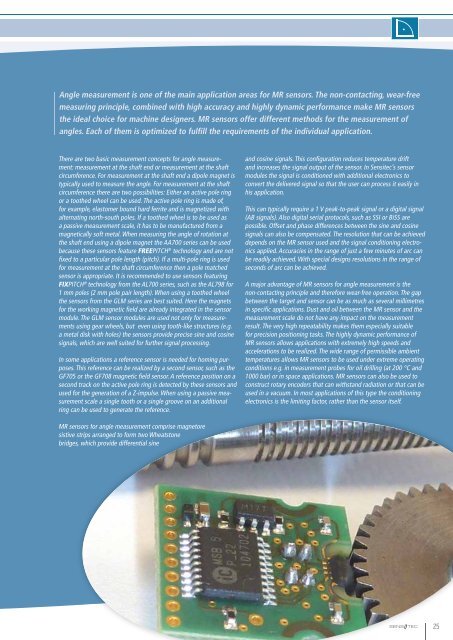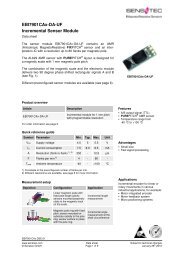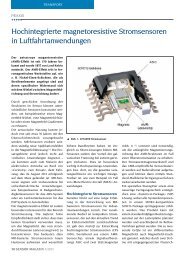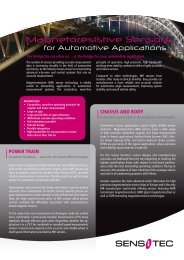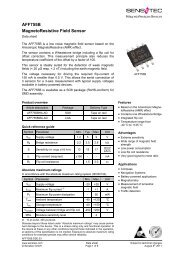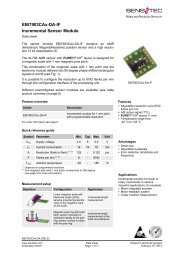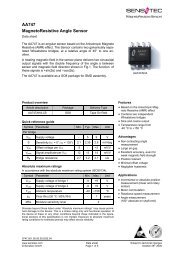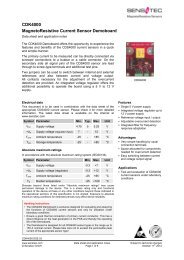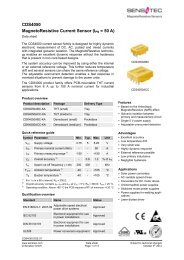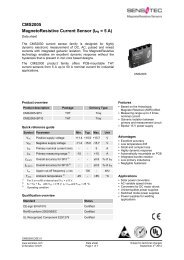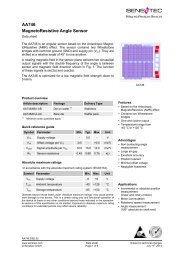WILLKOMMEN IM SENSOR KOSMOS WELCOME TO THE SENSOR COSMOS
WILLKOMMEN IM SENSOR KOSMOS WELCOME TO ... - Sensitec
WILLKOMMEN IM SENSOR KOSMOS WELCOME TO ... - Sensitec
- No tags were found...
Create successful ePaper yourself
Turn your PDF publications into a flip-book with our unique Google optimized e-Paper software.
Angle measurement is one of the main application areas for MR sensors. The non-contacting, wear-freemeasuring principle, combined with high accuracy and highly dynamic performance make MR sensorsthe ideal choice for machine designers. MR sensors offer different methods for the measurement ofangles. Each of them is optimized to fulfill the requirements of the individual application.There are two basic measurement concepts for angle measurement:measurement at the shaft end or measurement at the shaftcircumference. For measurement at the shaft end a dipole magnet istypically used to measure the angle. For measurement at the shaftcircumference there are two possibilities: Either an active pole ringor a toothed wheel can be used. The active pole ring is made of,for example, elastomer bound hard ferrite and is magnetized withalternating north-south poles. If a toothed wheel is to be used asa passive measurement scale, it has to be manufactured from amagnetically soft metal. When measuring the angle of rotation atthe shaft end using a dipole magnet the AA700 series can be usedbecause these sensors feature FreePITCH ® technology and are notfixed to a particular pole length (pitch). If a multi-pole ring is usedfor measurement at the shaft circumference then a pole matchedsensor is appropriate. It is recommended to use sensors featuringFIXPITCH ® technology from the AL700 series, such as the AL798 for1 mm poles (2 mm pole pair length). When using a toothed wheelthe sensors from the GLM series are best suited. Here the magnetsfor the working magnetic field are already integrated in the sensormodule. The GLM sensor modules are used not only for measurementsusing gear wheels, but even using tooth-like structures (e.g.a metal disk with holes) the sensors provide precise sine and cosinesignals, which are well suited for further signal processing.In some applications a reference sensor is needed for homing purposes.This reference can be realized by a second sensor, such as theGF705 or the GF708 magnetic field sensor. A reference position on asecond track on the active pole ring is detected by these sensors andused for the generation of a Z-impulse. When using a passive measurementscale a single tooth or a single groove on an additionalring can be used to generate the reference.and cosine signals. This configuration reduces temperature driftand increases the signal output of the sensor. In Sensitec’s sensormodules the signal is conditioned with additional electronics toconvert the delivered signal so that the user can process it easily inhis application.This can typically require a 1 V peak-to-peak signal or a digital signal(AB signals). Also digital serial protocols, such as SSI or BiSS arepossible. Offset and phase differences between the sine and cosinesignals can also be compensated. The resolution that can be achieveddepends on the MR sensor used and the signal conditioning electronicsapplied. Accuracies in the range of just a few minutes of arc canbe readily achieved. With special designs resolutions in the range ofseconds of arc can be achieved.A major advantage of MR sensors for angle measurement is thenon-contacting principle and therefore wear-free operation. The gapbetween the target and sensor can be as much as several millimetresin specific applications. Dust and oil between the MR sensor and themeasurement scale do not have any impact on the measurementresult. The very high repeatability makes them especially suitablefor precision positioning tasks. The highly dynamic performance ofMR sensors allows applications with extremely high speeds andaccelerations to be realized. The wide range of permissible ambienttemperatures allows MR sensors to be used under extreme operatingconditions e.g. in measurement probes for oil drilling (at 200 °C and1000 bar) or in space applications. MR sensors can also be used toconstruct rotary encoders that can withstand radiation or that can beused in a vacuum. In most applications of this type the conditioningelectronics is the limiting factor, rather than the sensor itself.MR sensors for angle measurement comprise magnetoresistivestrips arranged to form two Wheatstonebridges, which provide differential sine25


